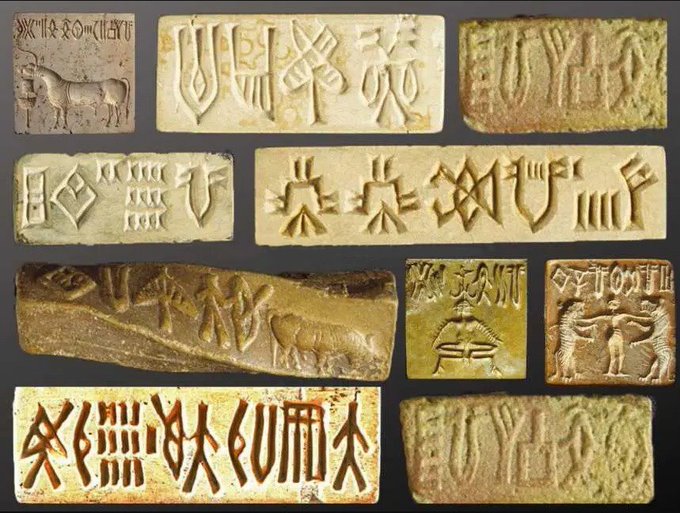
Posted on 06/19/2025 12:52:37 PM PDT by Red Badger
The government of Tamil Nadu has announced a $1 million reward for anyone who can successfully decipher the cryptic script of the ancient Indus Valley Civilization (IVC). Chief Minister M.K. Stalin made the announcement following a new study that suggests significant connections between symbols in the Indus script and markings found on ancient Tamil pottery.
The Enigma of the Indus Valley Script The Indus Valley Civilization, which flourished around 5,000 years ago in the fertile plains of the Indus River (present-day northwest India and Pakistan), is known for its advanced urban planning and extensive trade networks. However, one of its most intriguing aspects remains unsolved: the civilization’s script. Despite more than a century of research, the script, which consists of approximately 4,000 inscriptions, has remained undeciphered. Most of these inscriptions are brief, typically consisting of five to six symbols, and are found primarily on seals, pottery, and tablets.
One of the greatest obstacles to understanding the Indus script is the absence of longer inscriptions or bilingual artifacts—such as the famous Rosetta Stone—that could help unlock its meaning. While scholars have proposed various theories over the years, ranging from connections to Dravidian languages, early Brahmi, and even Sumerian, none have gained universal acceptance.
A New Theory Emerges
Recent research has brought fresh hope for deciphering the Indus script. Scholars K. Rajan and R. Sivananthan have compared over 14,000 ceramic sherds from Tamil Nadu and discovered striking similarities between these markings and those of the Indus script. Their findings suggest that as much as 60% of the symbols match, hinting at a possible cultural connection between the Indus Valley and southern India.
This revelation has inspired renewed excitement among researchers, including linguists, archaeologists, and computer scientists, many of whom are eager to decode the script once and for all.
The Reward and the Race to Decipher the Script
The $1 million prize has sparked a global race among experts to crack the code. Some researchers, such as Nisha Yadav from the Tata Institute of Fundamental Research, have turned to machine learning to analyze the patterns in the script.
Machine learning techniques have been successfully used in other areas of linguistic analysis, so their application to the Indus script holds promise. However, some experts remain skeptical about the effectiveness of machine learning in fully understanding such an ancient and enigmatic system of writing.
The prize announcement has already drawn attention from a wide range of disciplines, and the possibility of unlocking the secrets of the Indus Valley civilization’s language is now closer than ever.
What Could Decoding the Script Reveal?
Successfully deciphering the Indus script would offer unparalleled insights into the culture, governance, trade, and spiritual beliefs of the Indus Valley Civilization. Given that the civilization was one of the earliest urban cultures in human history, understanding its language could reshape our understanding of early societies in South Asia and beyond.
With this new development, the mystery of the Indus Valley script remains one of the most tantalizing puzzles in archaeology and linguistics, and the $1 million prize will undoubtedly continue to draw attention from around the world.
I got the first row. It’s “Three rings for the Elven kings under the sky” - not liking where this is going...
Well, considering they had the first plumbing system yet found.... could be!
Ovaltine. You beat me with that one.
Noah was right!
Each symbol is a complete thought, not a word.
Send money! College tuition due!!
Heads up

The fifth one on the first set is a restaurant menu item. Says double lamb. With tziziki and a red wine. I looked at the other ones and I can make out, Slow children at play.
“No Parking” “Trespassers will be prosecuted to the fullest extent of the law.” “Naan loaves: 13 loaves for 1 rupee.”
I was thinking the same thing. As soon as AI gets a little smarter and has access to a larger database, all of these ancient language mysteries are going to be solved fairly quickly. This is the perfect task for AI.
Pretty sure Alabama used those on their sideline last season.
Geeze, everyone is over thinking it, it says 15 minutes can save you 15%.
sheesh, easypeesy.
I’m not knowledgeable enough to know exactly what would go into it, but I imagine AI will someday be very useful for this sort of thing.
(I think cryptanalysts - the Friedmans? - finally decided that the Voynich was just nonsense; but maybe AI can have a crack at that someday, too.)
My decoder ring must be faulty; it says ‘Sling lets you do that!’
M.K. Stalin, grand nephew of Josepf Stalin. You don’t see too many Stalin surnames anymore or ever.
A bigger problem is the dearth of samples. What do we have for this civilization, besides a lot of seals, stamps, tokens...? You can’t do much translating without subjects and predicates, nouns and verbs.
AI might be very helpful here. Take every known ancient script, every sample. Indus Valley is most likely related to Dravidian but you never know.
A Rosetta Stone doesn’t turn up often enough. Or as I’ve often said, it’d be wonderful if we found someone buried with a library to pass the time in their afterlife — and they had a convenient Etruscan-Latin dictionary, or a Linear A -Greek.
Maybe other languages too.
Disclaimer: Opinions posted on Free Republic are those of the individual posters and do not necessarily represent the opinion of Free Republic or its management. All materials posted herein are protected by copyright law and the exemption for fair use of copyrighted works.